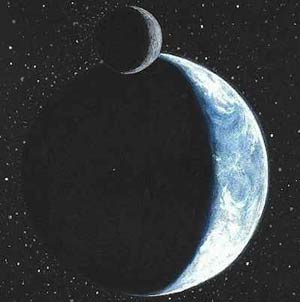Moon, witnesses precious about the mysteries of the solar system
The Moon, the goal of a new international race is seen as a precious witness to the history and mysteries of the Solar System since its birth 4.5 million years ago.
 (Artwork: cyberwitch) The only natural satellite of the Earth at 384.402 km away, the Moon is still mysterious even though there have been 10 US-based missions on this planet within the framework of the program. Apollo from 1968 to 1972.
(Artwork: cyberwitch) The only natural satellite of the Earth at 384.402 km away, the Moon is still mysterious even though there have been 10 US-based missions on this planet within the framework of the program. Apollo from 1968 to 1972.
A recent report by the American Academy of Science affirmed that returning to the Moon will help carry out new scientific research and supplement knowledge about the solar system.
On the surface of the Moon there was a thick layer of dust called regolith, the result of meteorite collisions. This dust contains oxygen that is easy to exploit and hydrogen but with less content.
Oxygen and hydrogen can be used to fuel rocket engines, greatly reducing the cost of space exploration and allowing the launch of spacecraft outside the Earth's atmosphere.
Regolith also contains silicon that can be used to make solar panels. Many companies have investigated the possibility of making these batteries to supply power to future Moon space stations.
The Moon's surface also stores many helium-3, a rare non-radioactive isotope on Earth, ideal for fusion reactions.
The Moon can hold up to 1 million tons of helium-3 while just 25 tons is enough to meet the needs of the US or the European Union.
This potential has led Russia's Energia Space Corporation to reveal from early 2006 a project to establish a permanent base on the Moon in the next 10 years and to conquer helium-3 precious isotopes around 2020.
However, this resource exploitation technology is still at a new stage of preparation.
WITH
- 10 mysteries in the solar system that scientists have not yet explained (1)
- Evidence of the first moon outside the solar system
- 10 mysteries in the solar system that scientists still cannot explain (2)
- Suddenly discovered a new moon in the Solar System
- Unexpectedly the size of the largest Moon in the solar system
- The Solar System has never been this beautiful
- The moon was a piece of earth?
- 'Lava moon' discovered outside the Solar System
- The Solar System and NASA's great discoveries
- NASA announced a place that could exist in the solar system
- Believe it or not, there have been 2 Earths in the Solar System
- What will the sky look like if the Moon is replaced?
 Van Allen's belt and evidence that the Apollo 11 mission to the Moon was myth
Van Allen's belt and evidence that the Apollo 11 mission to the Moon was myth The levels of civilization in the universe (Kardashev scale)
The levels of civilization in the universe (Kardashev scale) Today Mars, the sun and the Earth are aligned
Today Mars, the sun and the Earth are aligned The Amazon owner announced a secret plan to build a space base for thousands of people
The Amazon owner announced a secret plan to build a space base for thousands of people What would a day on the Moon be like for astronauts?
What would a day on the Moon be like for astronauts?  First photo of Mars' strangely shaped moon
First photo of Mars' strangely shaped moon  The biggest supermoon of the year is about to light up the world's skies
The biggest supermoon of the year is about to light up the world's skies  New research shows that Earth has a new 'Moon'
New research shows that Earth has a new 'Moon'  James Webb Telescope Discovers Rare Scene From Saturn's Moon
James Webb Telescope Discovers Rare Scene From Saturn's Moon  Shock Detected on the Dark Side of the Moon: Structure Identical to Earth!
Shock Detected on the Dark Side of the Moon: Structure Identical to Earth! 